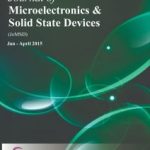Open Access

Subhadeep Mukhopadhyay
- Assistant Professor, National Institute of Technology Arunachal Pradesh, Arunachal Pradesh, India
Abstract
Maskless lithography, hot embossing lithography and direct bonding technique are useful to fabricate the polymethylmethacrylate (PMMA) microfluidic devices. Also, maskless lithography and indirect bonding technique are useful to fabricate the SU-8 based glass microfluidic devices. In this work, a short review on microfluidic flow and microfluidic filtration of microparticles is provided by author related to the micron-scale fluid mechanics. This review may be useful to perform the blood filtration in microfluidic lab-on-a-chip systems. Also, this review may be helpful to fabricate the nanofluidic devices and systems. Liquid-microflow is slower at higher surface-area to volume ratio inside the microchannel. The surface-to-volume ratio is generally very high inside any Nanochannel. Therefore, the Liquid-flow may be stopped before the Nanochannel. Hence, only gas-Nanoflow may happen inside the Nanochannel producing the subject of Nanofluidics. Also, this work may be useful to fabricate the fluidic microelectromechanical systems (MEMS).
Keywords: : Passive capillary flow; Microchannel bend; Aqueous suspension; Separation
[This article belongs to Journal of Microelectronics and Solid State Devices(jomsd)]

Browse Figures
References
1. C. C. Chang, R. J. Yang, “Electrokinetic Mixing in Microfluidic Systems”, Microfluid Nanofluid, Vol. 3 (2007) Pages 501-525.
2. F. Mugele, J. C. Baret, “Electrowetting: from Basics to Applications”, Journal of Physics: Condensed Matter, Vol. 17 (2005) Pages R705-R774.
3. R. Pethig, “Review Article—Dielectrophoresis: Status of the Theory, Technology, and Applications”, Biomicrofluidics, Vol. 4 (2010) Page 022811.
4. S. Mukhopadhyay, J. P. Banerjee, S. S. Roy, S. K. Metya, M. Tweedie, J. A. McLaughlin, “Effects of Surface Properties on Fluid Engineering Generated by the Surface-Driven Capillary Flow of Water in Microfluidic Lab-on-a-Chip Systems for Bioengineering Applications”, Surface Review and Letters, Vol. 24, No. 3 (2017) Page 1750041.
5. S. Mukhopadhyay, S. S. Roy, Raechelle A. D’Sa, A. Mathur, R. J. Holmes, J. A. McLaughlin, “Nanoscale Surface Modifications to Control Capillary Flow Characteristics in PMMA Microfluidic Devices”, Nanoscale Research Letters, Vol. 6 (2011) Page 411.
6. S. Mukhopadhyay, J. P. Banerjee, S. S. Roy, “Effects of Channel Aspect Ratio, Surface Wettability and Liquid Viscosity on Capillary Flow through PMMA Sudden Expansion Microchannels”, Advanced Science Focus, Vol. 1, No. 2 (2013) Pages 139-144.
7. S. Mukhopadhyay, “Optimisation of the Experimental Methods for the Fabrication of Polymer Microstructures and Polymer Microfluidic Devices for Bioengineering Applications”, Journal of Polymer & Composites, Vol. 4, Issue 3 (2016) Pages 8-26.
8. J. Goldberger, R. Fan, P. Yang, “Inorganic Nanotubes: A Novel Platform for Nanofluidics”, Accounts of Chemical Research, Vol. 39, No. 4 (2006) Pages 239-248.
9. H. Cao, J. O. Tegenfeldt, R. H. Austin, S. Y. Chou, “Gradient Nanostructures for Interfacing Microfluidics and Nanofluidics”, Applied Physics Letters, Vol. 81, No. 16 (2002) Pages 3058-3060.
10. B. Bhushan, “Nanotribology and Nanomechanics of MEMS/NEMS and BioMEMS/BioNEMS Materials and Devices”, Microelectronic Engineering, Vol. 84 (2007) Pages 387-412.
11. J. K. Luo, Y. Q. Fu, H. R. Le, J. A. Williams, S. M. Spearing, W. I. Milne, “Diamond and Diamond- like Carbon MEMS”, Journal of Micromechanics and Microengineering, Vol. 17 (2007) Pages S147-S163.
12. W. M. Zhang, G. Meng, X. Wei, “A Review on Slip Models for Gas Microflows”, Microfluid Nanofluid, Vol. 13 (2012) Pages 845-882.
13. W. Sparreboom, A. V. D. Berg, J. C. T. Eijkel, “Transport in Nanofluidic Systems: A Review of Theory and Applications”, New Journal of Physics, Vol. 12 (2010) Page 015004.
14. D. Mijatovic, J. C. T. Eijkel, A. V. D. Berg, “Technologies for Nanofluidic Systems: top-down vs. bottom-up —— A Review”, Lab on a Chip, Vol. 5 (2005) Pages 492-500.
15. H. G. Craighead, “Nanoelectromechanical Systems”, Science, Vol. 290 (2000) Pages 1532-1535.

Journal of Microelectronics and Solid State Devices
| Volume | 8 |
| Issue | 3 |
| Received | February 1, 2022 |
| Accepted | February 17, 2022 |
| Published | January 17, 2023 |

